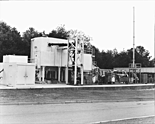

Vitrification is a waste treatment that turns mixed waste into glass. It provides a stable, non-leaching waste glass product suitable for long-term storage. Vitrification also reduces the volume of waste by evaporating water, oxidizing organics into harmless gases, and consolidating metals and other contaminants into non-porous solids. Drawbacks to vitrification are that transporting waste to vitrification facilities increases the risk of worker exposure and waste-related transportation incidents and that vitrification facilities can be expensive to construct.
A possible solution to these problems is a modular, transportable vitrification system for mixed waste called TVS, which costs less than $5 million. TVS was designed and fabricated by Envitco, Inc. of Toledo, Ohio, which has a U.S. patent pending. TVS was built to be moved from site to site to treat some of the U.S. Department of Energy's small to medium low-level mixed waste streams.
The first process step in TVS is mixing wastes with additives, such as sand, soda ash, borax, lime, or alumina, to promote the formation of a stable glass product. The mixture enters Envitco's Joule-heated melter, where currents passing between electrodes transform the waste mixture into a molten state. This process decomposes and dissolves inorganics and locks radioactive materials into the glass melt. The melter's off-gas system captures and treats any vapors from the melt. The molten material is poured into steel containers as it is produced. After cooling, the containers of glass are stored for eventual disposal.
Moving TVS requires about 12 tractor trailers for its five modules: feed preparation, melter, off-gas, control and services, and process laboratory. Transport and reassembly of TVS takes about six weeks. TVS is designed to produce 300 pounds of glass per hour (depending on the type of waste) and to process wet, dry, and slurried waste, which is a semiliquid material mixed with clay or soil.
 The
Westinghouse Savannah River Company, which operates the U.S. Department
of Energy's Savannah River Site, conducted shakedown testing of TVS
at Clemson University's Environmental Systems Engineering Department.
This testing produced 25,000 pounds of glass from non-radioactive
material resembling slurried waste. This simulated waste closely resembled
the chemical makeup of common mixed waste forms found at the Oak Ridge
K-25 Site.
The
Westinghouse Savannah River Company, which operates the U.S. Department
of Energy's Savannah River Site, conducted shakedown testing of TVS
at Clemson University's Environmental Systems Engineering Department.
This testing produced 25,000 pounds of glass from non-radioactive
material resembling slurried waste. This simulated waste closely resembled
the chemical makeup of common mixed waste forms found at the Oak Ridge
K-25 Site.
Lockheed Martin Energy Research Corporation, operator of DOE's Oak Ridge National Laboratory, is in the process of obtaining regulatory permits for using TVS to treat radioactive waste from the K-25 Site. K-25 was chosen as a testing ground because of the wide variety of waste streams found there. TVS will be used to treat pond sludges containing low-level mixed wastes from the K-25 Site's B and C waste pond cleanup project.
For a fact sheet on the Transportable Vitrification System, visit the Oak Ridge National Laboratory homepage at http://www.ornl.gov/emef/facts/mobile.htm.
![]()
![]()
![]()